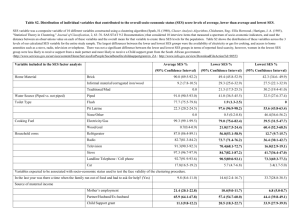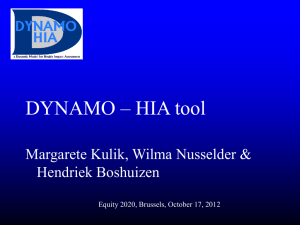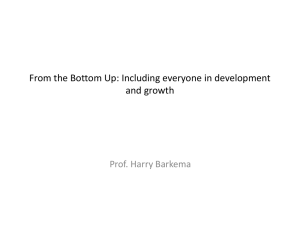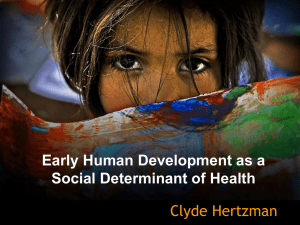file - BioMed Central
advertisement
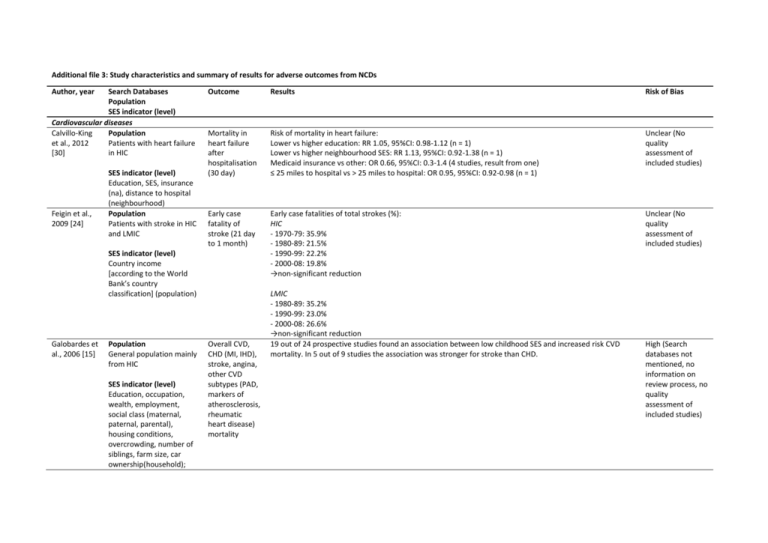
Additional file 3: Study characteristics and summary of results for adverse outcomes from NCDs Author, year Search Databases Population SES indicator (level) Cardiovascular diseases Calvillo-King Population et al., 2012 Patients with heart failure [30] in HIC Feigin et al., 2009 [24] SES indicator (level) Education, SES, insurance (na), distance to hospital (neighbourhood) Population Patients with stroke in HIC and LMIC Outcome Results Risk of Bias Mortality in heart failure after hospitalisation (30 day) Risk of mortality in heart failure: Lower vs higher education: RR 1.05, 95%CI: 0.98-1.12 (n = 1) Lower vs higher neighbourhood SES: RR 1.13, 95%CI: 0.92-1.38 (n = 1) Medicaid insurance vs other: OR 0.66, 95%CI: 0.3-1.4 (4 studies, result from one) ≤ 25 miles to hospital vs > 25 miles to hospital: OR 0.95, 95%CI: 0.92-0.98 (n = 1) Unclear (No quality assessment of included studies) Early case fatality of stroke (21 day to 1 month) Early case fatalities of total strokes (%): HIC - 1970-79: 35.9% - 1980-89: 21.5% - 1990-99: 22.2% - 2000-08: 19.8% →non-significant reduction Unclear (No quality assessment of included studies) SES indicator (level) Country income [according to the World Bank’s country classification] (population) Galobardes et al., 2006 [15] Population General population mainly from HIC SES indicator (level) Education, occupation, wealth, employment, social class (maternal, paternal, parental), housing conditions, overcrowding, number of siblings, farm size, car ownership(household); Overall CVD, CHD (MI, IHD), stroke, angina, other CVD subtypes (PAD, markers of atherosclerosis, rheumatic heart disease) mortality LMIC - 1980-89: 35.2% - 1990-99: 23.0% - 2000-08: 26.6% →non-significant reduction 19 out of 24 prospective studies found an association between low childhood SES and increased risk CVD mortality. In 5 out of 9 studies the association was stronger for stroke than CHD. High (Search databases not mentioned, no information on review process, no quality assessment of included studies) Galobardes et al., 2004 [10] maternal marital status, single-parent family and other indirect SES measures Population General population mostly in HIC SES indicator (level) Education (parental), occupation (paternal), housing conditions, overcrowding, number of siblings, home ownership, farm size (household); maternal marital status and presence of both natural parents during childhood Overall CVD, CHD (MI, IHD), stroke, overall cancer, lung cancer, other cancers, COPD mortality 5 out of 9 studies found a higher risk of overall CVD mortality among those with low childhood SES, with results generally remaining statistically significant after adjustment for adult SES and/or adult CVD risk factors. 7 out of 10 studies found a higher risk of CHD mortality among those with low childhood SES, although adult SES attenuated the association in some studies. 4 out of 6 studies found a higher risk of stroke mortality among those with low childhood SES. High (Search databases not mentioned, no information on review process, no quality assessment of included studies) 4 out of 5 studies found no association between overall cancer mortality and childhood SES, and the effect was removed by adjustment for adult SES in the remaining study. 3 out of 3 studies found a higher risk of lung cancer mortality among those with low childhood SES, although the association was largely explained by adults SES in 2 studies. 1 study showed no association of childhood SES with a group of other smoking-related cancers. 1 study found a higher risk of stomach cancer mortality among those with low childhood SES, independent of adult circumstances. 1 study found a higher risk of large-bowl and rectal cancer among those who had the poorest housing conditions during childhood. There was no association between non-smoking related cancers (3 studies), prostate cancer (1 study) and malignant melanoma (1 study) mortality and childhood SES. Pollitt et al., 2005 [17] Population General population and patients with CVD and stroke from HIC SES indicator (level) Education, occupation, employment (parental/paternal); housing conditions, family size, perceived CVD (MI, IHD, carotid IMT; CHD, AP), stroke mortality 1 study did not find an association between higher COPD mortality and overcrowding. 11 out of 13 studies found a higher risk of CVD mortality among those with low childhood SES. Most associations remained statistically significant after adjustment for CVD risk factors and/or adult SES. 3 out of 3 studies showed a higher risk of stroke mortality among those with low childhood SES. Adjustment for adjustment for CVD risk factors and/or adult SES had minor impact on the effect. 5 out of 5 studies reported an association between cumulative life course exposure to low SES conditions and increased CVD mortality. High (Only one database searched) Sposato et al., 2012 [21] wealth, family situation, farm size (household) and other indirect SES measures Population Patients with stroke in HIC, MIC, and LIC SES indicator (level) PPP-aGDP, PPP-aTHE, unemployment rate (population) Cancers Canturk et al., 2010 [31] Galobardes et al., 2004 [10] Gorey et al., 2009 [20] Population Patients with retinoblastoma in upper middle, lower middle and low income countries SES indicator (level) Country income [according to the World Bank’s country classification] (population) Population General population mostly in HIC SES indicator (level) Education (parental), occupation (paternal), housing conditions, overcrowding, number of siblings, home ownership, farm size (household); maternal marital status and presence of both natural parents during childhood Population Patients with breast 30-day casefatality rates of stroke; intracerebral hemorrhages Lower PPP-aGDP correlated with higher 30-day case-fatality rates of stroke (ρ = -0.713, p < 0.001; R2 = 0.43) and a greater proportion of intracerebral hemorrhages (ρ = -0.689, p < 0.001; R2 = 0.43). Lower PPP-aTHE correlated with higher 30-day case-fatality rates of stroke (ρ = -0.701, p < 0.001; R2 = 0.45) and a greater proportion of intracerebral hemorrhages (ρ = -0.643, p < 0.001; R2 = 0.32). Unclear (Unclear if dual full-text review, no quality assessment of included studies) There was no correlation between unemployment and 30-day case-fatality rates of stroke (ρ= 0.204; p = 0.32, R2 = 0.04) and proportion of intracerebral hemorrhages (ρ = -0.258, p = 0.18; R2 = 0.04). Survival of retinoblastoma Estimated survival of retinoblastoma: Upper middle income countries 79% (range, 54-93%) Lower middle income countries 77% (range, 60-92%) Unclear (Unclear if dual full-text review, no quality assessment of included studies) Low income countries 40% (range, 23-70%) p = 0.001 Overall cancer, lung cancer, and other cancers mortality 4 out of 5 studies found no association between overall cancer mortality and childhood SES, and the effect was removed by adjustment for adult SES in the remaining study. 3 out of 3 studies found a higher risk of lung cancer mortality among those with low childhood SES, although the association was largely explained by adults SES in 2 studies. 1 study showed no association of childhood SES with a group of other smoking-related cancers. 1 study found a higher risk of stomach cancer mortality among those with low childhood SES, independent of adult circumstances. High (Search databases not mentioned, no information on review process, no quality assessment of included studies) 1 study found a higher risk of large-bowl and rectal cancer among those who had the poorest housing conditions during childhood. Breast cancer survival There was no association between non-smoking related cancers (3 studies), prostate cancer (1 study) and malignant melanoma (1 study) mortality and childhood SES. Within Canada, there was no association between area-SES and breast cancer survival, a little survival disadvantage was only observed for lowest income areas compared to highest income areas (pooled RR 0.94, High (Only one database cancer in the US and Canada 95%CI 0.93-0.95). SES indicator (level) Income (neighbourhood) Slatore et al., 2010 [25] Population Patients with lung cancer in the US Lung cancer mortality Within the US, breast cancer survival was consistently associated with area-SES. Women with breast cancer from low and middle income areas had survival disadvantage compared to women from high income areas (pooled RR ranging from 0.73, 95%CI 0.72-0.74 for low to 0.96, 95%CI 0.94-0.98 for middle income area compared with high income areas). 4 out of 4 studies showed a higher risk for lung cancer mortality for Medicaid insurance compared to other or private insurance. 2 studies showed mixed results on the association between Medicare vs Medicaid/Medicare and lung cancer mortality. SES indicator (level) Insurance status (individual) searched, no information on review process, no quality assessment of included studies) Unclear (No dual quality assessment of included) 1 study showed a higher risk for lung cancer mortality for Medicare insurance and no insurance compared to private insurance. 2 studies showed no association between lung cancer mortality and insurance status (other vs private and commercial vs other). 1 study found mixed results for lung cancer mortality and different Medicare schemes. Chronic respiratory diseases Galobardes et Population al., 2004 [10] General population mostly in HIC Gershon et al., 2012 [29] SES indicator (level) Education, occupation, wealth (parental) , housing conditions, overcrowding, number of siblings, residence in orphanage (household); maternal marital status or illegitimacy and other indirect SES measures Population Patients with COPD in HIC SES indicator (level) Education, occupation COPD mortality 1 study did not find an association between higher COPD mortality and overcrowding in childhood. High (Search databases not mentioned, no information on review process, no quality assessment of included studies) COPD mortality Individuals of the lowest SES consistently had significantly higher mortality from COPD than those of the highest (point estimates of rate ratio ranging from 1.1-10.8, RR ranging from 1.9-2.5), except for 1 study (out of 5) where income was not associated with COPD mortality (OR 0.8, 95%CI 0.5-1.3). Low and/ or income (na) SES = Socioeconomic status; COPD = Chronic obstructive pulmonary disease; na = not available; RR = Relative risk; OR = Odds ratio; CI = Confidence interval; p = p-value; n = number of studies; US = United States; PPP-aGDP = Per capita GDP adjusted for purchasing power parity; PPP-aTHE = total health expenditures per capita at purchasing power parity; ρ = Spearman rank correlation coefficient; R² = Effect size; y = years; NCDs = Non-communicable diseases; vs = versus; LMIC = Low and middle income countries; HIC = High income countries; MIC = Middle income countries; LIC = Low income countries; MI = Myocardial infarction; CVD = Cardiovascular diseases; CHD = Coronary heart disease; IHD = Ischaemic heart disease; IMT = Intima-media thickness; AP = Angina pectoris;

